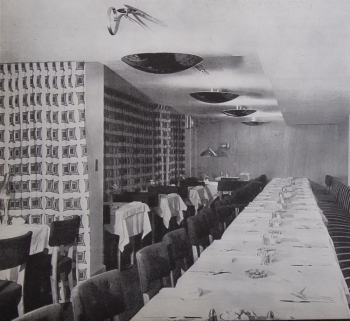On tours of Saarinen House, visitors in the dining room are sandwiched between Greta Skogster’s hanging and leaded glass doors. They look one way to see a courtyard with leafed-out trees beyond; they look the other way to see a wall-sized hanging with birds and a tree and foliage.
Greta Skogster (1900-1994) herself was a one-woman phenomenon, running her own textile business in Finland. She was born in the small southwest town of Hämeenlinna in 1900, and as far as I can gather studied textiles at the Helsinki Central School of Arts and Crafts. At the time, in the 1920s, students from educated backgrounds were not actually trained to operate a loom. They became designers and managers and engaged others to manufacture their designs.

Greta Skogster-Lehtinen at work. Image © Greta and William Lehtinen Foundation
Skogster founded her own company in 1929, named it Textile Office, and started producing hand-made designs by the yard and carpets for commercial use. In 1930 her work appeared alongside that of architects Alvar and Aino Aalto in the Small Apartment Exhibition in Helsinki, and from there her company grew apace.
Enter William Lehtinen (1895-1975) who went from studying forestry in Helsinki to earning his Masters of Forestry at Yale in 1926. He served as a trade attaché for Finland’s wood processing industries before returning home in 1930 to join the firm of Enso-Gutzeit, Finland’s largest pulp and paper company. So talented was forester Lehtinen that he rescued the company from post-war ruin and outmoded Russian machinery and became its CEO, transforming Finnish paper production along the way. The company still exists.
By 1937 Skogster and Lehtinen were married and had moved her studio to Enso in eastern Finland, where her Textile Office became one of the largest private textile companies in the country with power looms and 23 employees. If you had been in Finland at that time you would have seen her work on Finnish trains, on the seats of factory offices, in all the best restaurants, in the headquarters of Enso-Gutzeit and in the upholstery of Eliel Saarinen’s Helsinki Central Railway Station. Her textiles even come to the USA at the 1947 Finnish House in New York’s Murray Hill where the Finnish American Trading Company had set up a showroom to promote trade.

Interior of The Finland House with hangings by Greta Skogster-Lehtinen at 39-41 East 50th Street, New York, New York, 1947. Image ©paavotynell.org
Skogster-Lehtinen and husband William went on to lead a good life, devoting their time, money and effort into collecting art and promoting the arts and crafts. By 1964 they intended to establish a museum designed by old friend Alvar Aalto, but an inability to break through Helsinki’s historic area building restrictions meant the museum was never built. Undaunted, the couple established The Greta and William Lehtinen Foundation offering fellowships for artists, artisans, musicians and architects, which, in true Lehtinen fashion, still exists.

Greta Skogster-Lehtinen and William Lehtinen with family. Image © Greta and William Lehtinen Foundation
How the Saarinens came to choose a hanging from Greta Skogster for the dining room in their Cranbrook, Michigan house is not clear, nor do we yet know what the relationship was between the two families, though one must assume they knew each other. According to the Cranbrook Center for Collections and Research object record the hanging was acquired between 1935 and 1939. There exists a 1980 letter from Cranbrook to Skogster-Lehtinen, now living in Tampere after the death of her husband, enquiring about the hanging but no reply.
But what a piece, cleaned, restored and still reminding visitors of the serenity of a forested world, where large wood grouse flit amongst the leaves!

Skogster’s tapestry hanging in the Dining Room of Saarinen House, Copyright Balthazar Korab/Cranbrook Art Museum.
This is not a tapestry in the true sense of the word, where the weft is continuous. This hanging employs many different techniques, including supplemental wefts and rectangular patches left with bare warp so that the fir paneling can show through. Echoing the luxury of the gold leaf in the dome over the table, there is gold thread and silk amongst the linen, cotton and rayon. It does recall other Skogster-Lehtinen pieces, many of which are quite large.
Needless to say, there is more to discover in the long life of this prolific designer, and the Saarinen connection puzzle remains to be solved.
–Lynette Mayman, Collections Interpreter, Cranbrook Center for Collections and Research
Sources:
Greta ja William Lehtisen Säätiö (Greta and William Lehtinen Foundation), 2007. http://www.gretajawilliamlehtinen.fi
Scandinavian Design: Alternative Histories, edited by Kjetil Fallan (Oxford, UK: Berg Publishers, 2012).
Göran Schildt, Alvar Aalto, A Life’s Work: Architecture, Design and Art (Helsinki, Finland: Otava Publishing Company, 1994).
Works by Greta Skogster, FJ Hakimian. http://fjhakimian.com/greta-skogster

Thanks Lynette! It’s great to hear your voice and perspective on the blog!
LikeLiked by 1 person
Hi!
I always enjoy the Cranbrook Kitchen Sink posts–thanks for doing them!
I have a question about one of the images in the Greta Skogster post–the interior of The Finland House credits the textiles to Skogster, but that looks an awful lot like Pipsan Saarinen Swanson’s design to me (maybe the one titled Purist’s Choice by Goodall?). Did you encounter overlap in their design credits?
Thanks!
Ashley Brown Callahan
(former museum intern/fellow)
Sent from Outlook
________________________________
LikeLike
I knew the Lady and have numerous artifacts by her. I would be inclined to write personal emails to L.M. rather than post comments here.
LikeLike
Wonderful! Thank you for your interest. You can reach Lynette at LMayman@cranbrook.edu
LikeLike